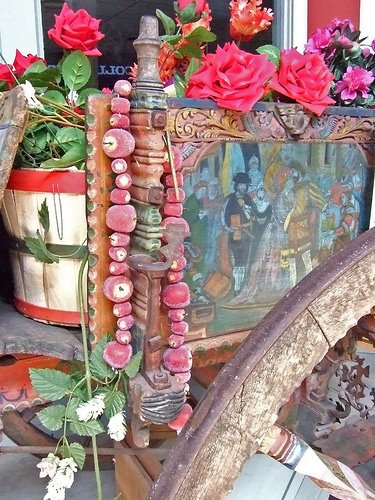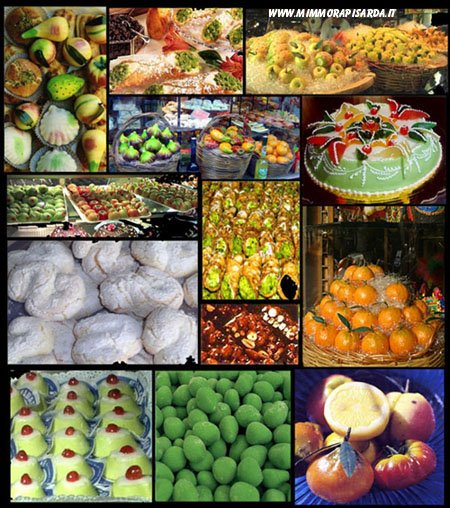
The chocolate in Modica is famous for its tradition : A tradition that was handed down from the Aztecs to the Spaniards and then to the Sicilians when Sicily was controlled by the Spanish from 13th to the 15th century.
This is a story about chocolate. It's also a tale of discovery that we want to share with you, as written on the International Herald's Tribune.
It begins with the ancient culture of the Aztecs in Mexico, and ends, at least for our purposes, in the charming Baroque town of Modica, just inland from Sicily's southern coast, an area of remarkable natural beauty where history still lives in the sights, sounds and tastes of the present.
In the early 1500s, the Spanish conquistadors of the New World came into contact with an extraordinary variety of hitherto unknown foods. One of these was xocolatl, obtained from ground cacao seeds. Ingested in solid form or as a beverage, it was much appreciated by the Aztecs for its invigorating properties and the sense of well-being it induced.
In his "Historia Verdadera de Nueva Espana," Bernal Diaz de Castillo, who followed the Grand Conquistador, Cortes to Mexico, described how the Emperor Montezuma used to drink bitter chocolate, sometimes spiced with vanilla.
Sicily became acquainted with various foodstuffs from those distant Spanish dominions as the island gradually adapted to Spanish rule.
In the early 1500s, the Spanish conquistadors of the New World came into contact with an extraordinary variety of hitherto unknown foods. One of these was xocolatl, obtained from ground cacao seeds. Ingested in solid form or as a beverage, it was much appreciated by the Aztecs for its invigorating properties and the sense of well-being it induced.
In his "Historia Verdadera de Nueva Espana," Bernal Diaz de Castillo, who followed the Grand Conquistador, Cortes to Mexico, described how the Emperor Montezuma used to drink bitter chocolate, sometimes spiced with vanilla.
Sicily became acquainted with various foodstuffs from those distant Spanish dominions as the island gradually adapted to Spanish rule.
For Modica and the surrounding county of the same name, this period coincided with an age of exceptional wealth and development, to the extent that it was considered an island within the island, a kingdom within the kingdom.
Then in January 1693 a terrible earthquake devastated much of the town and killed 2,400 people. Despite the destruction, the positive spirit of Modica endured. While churches, monasteries and palaces had to be built anew, thus giving rise to the glorious chapter of Baroque architecture and urban planning that makes this part of Sicily such a visual treat, certain traditions survived unscathed. One of them was preparing bitter chocolate and using it in savory cuisine.
Leonardo Sciascia, the great 20th-century Sicilian writer, declared that "Modican chocolate is unparalleled in savor, such that tasting it is like reaching the archetype, the absolute, and that chocolate produced elsewhere, even the most celebrated, is an adulteration, a corruption of the original."
Leonardo Sciascia, the great 20th-century Sicilian writer, declared that "Modican chocolate is unparalleled in savor, such that tasting it is like reaching the archetype, the absolute, and that chocolate produced elsewhere, even the most celebrated, is an adulteration, a corruption of the original."
Since 1880 the high temple of archetypal chocolate in Modica has been the Antica Dolceria Bonajuto. A constant attraction for myriad devotees, local and otherwise, this wooden-paneled repository of toothsome treasures is tucked into a little side street just off Corso Umberto I, the main drag snaking through the rift between the two hillsides on which the town clings like crafted coral. Behind the counter is the inner sanctum where six young confectionery cooks practice an ancient art under the supervision of high priest Franco Ruta.
"This is a family enterprise by indirect descent," says Ruta, who divides his time between his profession as a medical analyst and his passion for chocolate. "Though people in Modica have been making chocolate and marzipan sweetmeats since time immemorial, it was my father-in-law's father-in-law who actually started up the shop.
"In fact the founder won the Grand Gold Medal Award for his products in the International Exhibition held in Rome in 1911. And we have been basically making things the same way ever since — nowadays of course with the help of electrical contrivances. My wife retired from teaching English at high school to work with us, and our son Pierpaolo is now also involved. In fact he set up our Web site."
Though the Antica Dolceria Bonajuto no longer ferments and grinds its own cacao seeds, it purchases the otherwise unprocessed chocolate mass direct from the Ivory Coast.
This contains all the original cocoa butter that makes the end product so rich and creamy, and that is largely lacking in industrially manufactured chocolate.
The crude chocolate is heated to around 40 to 50 degrees, when the cocoa butter melts and the basic ingredient can be worked together with cinnamon (or vanilla) and sugar until it is ready to be placed in the rectangular aluminium forms that give the sturdy little bars of chocolate their shape. Before the chocolate solidifies, these forms are lined up on a large wooden tray that is beaten relentlessly against the thick pale gray marble kitchen table top.
This extraordinary ritual makes a tremendous din, but actually serves to expel air bubbles and leave what will become the top side of the chocolate bars shiny and smooth. It remains only to wrap them in red or pink paper emblazoned with fin-de-siècle graphics.
The Ruta family and their enthusiastic team of young assistants also make the traditional mpanatigghi, (mm-pan-na-tee-gee) little empanadas stuffed with minced meat and chocolate, liccumie, a variant stuffed with eggplant and chocolate, and a variety of temptations made with locally grown almonds ground into a paste with sugar and then spiced with grated lemon rind and vanilla.
"This is a family enterprise by indirect descent," says Ruta, who divides his time between his profession as a medical analyst and his passion for chocolate. "Though people in Modica have been making chocolate and marzipan sweetmeats since time immemorial, it was my father-in-law's father-in-law who actually started up the shop.
"In fact the founder won the Grand Gold Medal Award for his products in the International Exhibition held in Rome in 1911. And we have been basically making things the same way ever since — nowadays of course with the help of electrical contrivances. My wife retired from teaching English at high school to work with us, and our son Pierpaolo is now also involved. In fact he set up our Web site."
Though the Antica Dolceria Bonajuto no longer ferments and grinds its own cacao seeds, it purchases the otherwise unprocessed chocolate mass direct from the Ivory Coast.
This contains all the original cocoa butter that makes the end product so rich and creamy, and that is largely lacking in industrially manufactured chocolate.
The crude chocolate is heated to around 40 to 50 degrees, when the cocoa butter melts and the basic ingredient can be worked together with cinnamon (or vanilla) and sugar until it is ready to be placed in the rectangular aluminium forms that give the sturdy little bars of chocolate their shape. Before the chocolate solidifies, these forms are lined up on a large wooden tray that is beaten relentlessly against the thick pale gray marble kitchen table top.
This extraordinary ritual makes a tremendous din, but actually serves to expel air bubbles and leave what will become the top side of the chocolate bars shiny and smooth. It remains only to wrap them in red or pink paper emblazoned with fin-de-siècle graphics.
The Ruta family and their enthusiastic team of young assistants also make the traditional mpanatigghi, (mm-pan-na-tee-gee) little empanadas stuffed with minced meat and chocolate, liccumie, a variant stuffed with eggplant and chocolate, and a variety of temptations made with locally grown almonds ground into a paste with sugar and then spiced with grated lemon rind and vanilla.
Chocolate is also part of a wider cuisine in Modica, as a visit to the Fattoria delle Torri will gloriously reveal. At Vicolo Napolitano 14, on a little side street off Corso Umberto, in what used to be the vaults of a patrician palazzo, this beautifully appointed restaurant is the gastronomic realm of Peppe Barone and his partners Massimo and Zelia.
Peppe is a quietly inventive cook, revisiting local recipes and traditions but derisive of the sort of culinary silliness that abounds when the accent is all on novelty.
Peppe sticks to seasonal produce, which is not hard in Sicily, but at most times of the year his menu features u lebbru 'nciucculattatu, rabbit cooked in chocolate. Of distant but evident Aztec provenance, this rich but delicate dish embodies a perfect balance of tastes and textures. To accompany it (and the other many delights of the day) the Fattoria delle Torri boasts what is possibly the finest wine cellar in Sicily.
Peppe is a quietly inventive cook, revisiting local recipes and traditions but derisive of the sort of culinary silliness that abounds when the accent is all on novelty.
Peppe sticks to seasonal produce, which is not hard in Sicily, but at most times of the year his menu features u lebbru 'nciucculattatu, rabbit cooked in chocolate. Of distant but evident Aztec provenance, this rich but delicate dish embodies a perfect balance of tastes and textures. To accompany it (and the other many delights of the day) the Fattoria delle Torri boasts what is possibly the finest wine cellar in Sicily.
Fattoria delle Torri
Vico Napolitano, 14
Modica (RG)
Phone : +39 0932 751286







Hello...found your blog through Sicily Guide...I have a very good friend that lives in Modicia..Welshcakes Limoncello...her blog is Sicily Scene...I will tell point her in the direction of your blog...she tells lots of things about Modica.
ReplyDeleteHi. I'm a British woman living in Modica. What a lovely blog you have. I knew something of the history of Modican chocolate and have blogged about our chocolate festival and Bonajuto's, but there is much information here that I didn't know about. Thank you.
ReplyDeleteHi s.j.simon
ReplyDeleteI had no idea chocolate was banned in Switzerland and brought back in the country by two italians! Thank you for the link. Very Interesting.